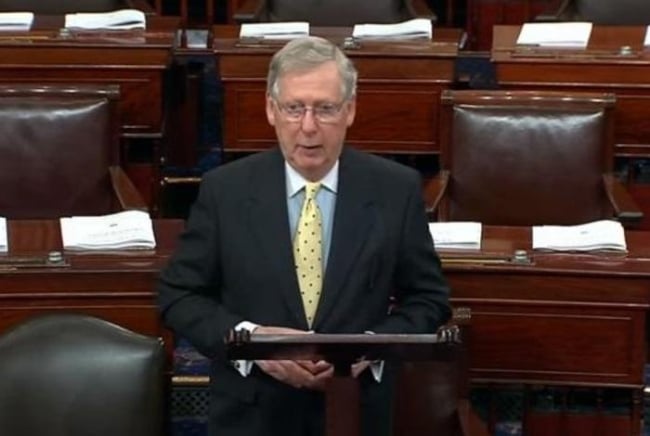You have /5 articles left.
Sign up for a free account or log in.

Senate Majority Leader Mitch McConnell speaks on the Senate floor about attempts to craft a coronavirus response stimulus package.
Office of Senator Mitch McConnell
As negotiations over a mammoth economic stimulus package continued in the Senate Monday night, House Democrats unveiled their own $2.5 trillion proposal, which largely mirrors, and in some ways goes beyond, the plan pushed by Senate Democrats to cancel large amounts of the nation's student debt.
The House plan also proposes giving more aid to colleges and universities than the Senate Republican plan would, but the American Council on Education worried the money will be distributed too slowly to save institutions in immediate need of help from layoffs or even closure.
The proposal largely mirrored the approach of Senate Democrats in using federal dollars to make the monthly federal student loan payments of Federal Family Education Loan, Perkins and direct loan borrowers for as long as a national emergency declaration over the coronavirus epidemic continues. After the declaration is lifted, borrowers would get a 90-day transition period in which they’d receive at least three notices indicating when they’d have to resume making payments. Missed payments would not result in fees or penalties during that time.
That approach was less than what the House financial committee wanted. It had recommended the payments be made for the duration of the emergency plus an additional six months.
Like the Senate Democratic plan, House Democrats would reduce the balances for borrowers by at least $10,000.
The idea of canceling borrowers' debt has been a sticking point during the negotiations in the Senate, where Republicans have only wanted to excuse borrowers from making monthly payments for six months, interest-free. But when the payments are required again, borrowers’ balances would be what they are now.
House Democrats would go further than their Senate counterparts in some respects. The proposal, which combined the recommendations of various House committees, also would make payments for borrowers of private student loans during the pandemic period and for six months afterward. Unlike the minimum of $10,000 of relief borrowers would receive under the Senate plan, in this version they would receive up to $10,000. Any remaining portion of the unused $10,000 would go to the private student loan borrower upon resumption of borrower payments.
The proposal also would allow an institution to use Supplemental Educational Opportunity Grants to provide emergency financial aid grants to help undergraduates or graduate students with unexpected expenses and other financial need during the emergency. Institutions would also be able to pay work-study students if they cannot work during the crisis.
To some observers, the proposal appeared to be designed to push negotiations in the Senate to the left.
“It certainly seems like the Senate Democrats are in a stronger position to get something based upon the two failed votes and a better House bill,” said Ben Miller, senior director for postsecondary education at the left-leaning Center for American Progress, after Democrats on Monday afternoon blocked an attempt by Senate Republicans for the second time to bring their plan up for debate.
But while Senate Republican aides declined comment on the House Democratic plan, it didn't go over well with Republicans in the House.
“This is a socialist dream agenda full of permanent policy changes that Democrats are attempting to jam through during an unprecedented public health and economic crisis,” Congresswoman Virginia Foxx, the top Republican on the House education committee, said in a statement, pointing to the $10,000 debt cancellation, as well as other proposals unrelated to higher education.
However, Representative Bobby Scott, the Democratic chairman of the House education committee, said in a statement, "The most effective way to help the American people through this public health crisis is to provide direct, immediate and prolonged financial relief."
All that left it unclear how the negotiations in the Senate, as well as those coming up between the Senate and House, would end up. “Predicting what’s going to happen is like predicting the running of the bulls in Pamplona,” said Terry Hartle, the American Council on Education’s senior vice president for government and public affairs. “I just know we’re getting to the finish line and it’s going to be fast.”
The proposal has more funding as well for higher education institutions than the $6 billion included in the Senate Republican plan, a figure that had distressed colleges and universities.
Thirty percent of $50 billion in education grants allocated to states in the House Democratic plan would be set aside for colleges and universities under the plan. Another 30 percent is earmarked for K-12 schools. Institutions also could get some of an additional 40 percent of state grants that could be distributed between K-12 and higher education.
In addition, another $9.5 billion, including $1.5 billion for historically black colleges and universities, would be distributed through an as-yet-undetermined federal grant process to reimburse institutions for coronavirus-related costs.
Associations representing colleges and universities had expressed deep disappointment over the $6 billion figure proposed by Senate Republicans, which would have been spread out among all institutions as well as students needing emergency aid to deal with campus closures.
But while Hartle said the House plan could funnel $15 billion to $35 billion to institutions, he was concerned the federal grant money wouldn’t arrive until well into next year.
That will be too late for institutions facing an “immediate, short-term cash crisis,” he said. Without more immediate help, he said, “many colleges will face immediate layoffs, budget cuts to programs and, in some cases, even closure.”



